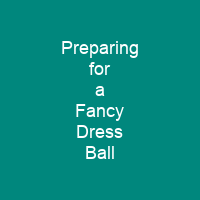Preparing for a Fancy Dress Ball: A Masterpiece by William Etty
Imagine stepping into the world of 19th-century England, where art and society intertwined in a unique way. This is exactly what you get when you look at ‘Preparing for a Fancy Dress Ball,’ an oil on canvas painting by English artist William Etty.
Etty painted this masterpiece in 1835, showcasing the daughters of Charles Watkin Williams-Wynn in lavish Italian-style costumes. The painting was commissioned by the family and exhibited at the Royal Academy Summer Exhibition that same year.
The Artist’s Journey
William Etty began his journey as an apprentice printer in Hull before moving to London at age 18, where he submitted paintings to the Royal Academy of Arts. His work was initially met with rejection or indifference, but he gained recognition after the exhibition of The Arrival of Cleopatra in Cilicia in 1821.
Etty became a full Royal Academician in 1828 and was known for his accurate depiction of flesh tones and his fascination with contrasts in skin tones. He specialized in nude painting, which caused controversy due to Britain’s lack of tradition for displaying nude material publicly.
Nude Paintings: A Controversial Yet Artistic Choice
“Whatever thy hand findeth to do, do it with all thy might!” Etty’s dedication to his craft is evident in the meticulous detail and technique he used. Despite criticism, he continued to paint nudes, making conscious efforts to reflect moral lessons in his work.
The Shift from History Painting to Portrait Painting
Etty’s admirers were angered by his shift from history painting to portrait painting, while critics believed he lacked technical skills in portraiture and was trying to capitalize on his name. However, the success of Preparing for a Fancy Dress Ball led to further commissions, boosting his status among the English elite.
The Legacy of William Etty
Etty’s legacy is complex, with critics generally disliking his portraits but appreciating his history paintings. The Williams-Wynn sisters, subjects of several Etty portraits, went on to have notable careers and personal lives.
The Painting’s Journey Through Time
Preparing for a Fancy Dress Ball was not publicly exhibited for 160 years after its initial exhibition in 1849. It was eventually purchased by the York Art Gallery in 2009 for £120,000, ensuring that this masterpiece remains accessible to art enthusiasts today.
Conclusion
William Etty’s Preparing for a Fancy Dress Ball is more than just a painting; it’s a window into the cultural and artistic landscape of 19th-century England. Through this work, we see the artist’s evolution from controversy to acceptance, his dedication to his craft, and the enduring legacy of his art.
So, next time you visit an art gallery or museum, take a moment to appreciate the stories behind each piece, just like Preparing for a Fancy Dress Ball tells us about its creator and the times it was painted in.
You want to know more about Preparing for a Fancy Dress Ball?
This page is based on the article Preparing for a Fancy Dress Ball published in Wikipedia (retrieved on November 29, 2024) and was automatically summarized using artificial intelligence.








